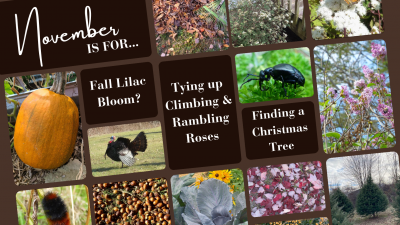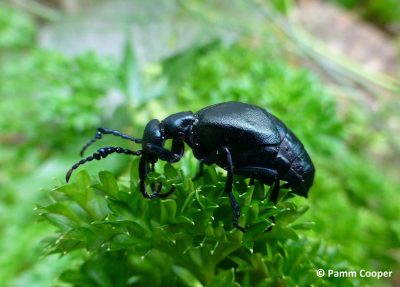Fall Lilac Bloom?

This fall many lilacs have bloomed for the second time this season. Stress factors such as heat, drought or the loss of most of the plant’s leaves can have a lot to do with spring blooming plants that become remontant (flowering out of season). This year a major stress to some lilacs was severe defoliation caused by a fungal pathogen known as Pseudocercospora. Infected leaves should be raked up and discarded to avoid the winter survival of the spores, which could cause re-infection next year if conditions are right. Plants should recover, and some flower buds may remain for bloom next spring.
November is a Good Time to Tie Climbing & Rambling Roses
Now is a good time to train climbing or rambling roses. Young canes are easy to tie due to their flexibility. In addition, tying them in the fall adds support and protects them from damaging winter winds. Canes can be tied to fences, posts or use a straining wire to create a support anywhere in your garden.
After the Turkey, Hunt for the Tree
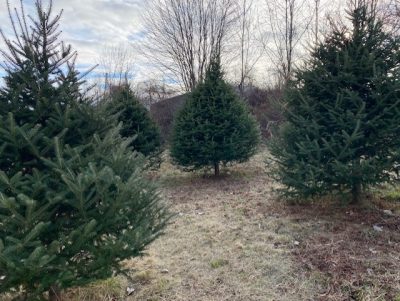
The holiday season is quickly approaching us! Many Connecticut families prepare to get their Christmas trees and holiday greens as early as Black Friday.
Finding the right species of tree can help you achieve your holiday decorating aesthetic and home needs. Consider not only the overall look of the tree, but also the sturdiness of the branches and texture of the needles. The classic Frasier Fir will have dense, compact needles, sturdy branches for hanging heavier ornaments and that unforgettable evergreen smell!
The Douglas fir will have softer needles and a brighter green color than its counterpart but be advised that lighter ornaments are best for this type of tree. The Concolor Fir has a more open and softer needle structure that creates a bushier look overall with a blueish tint. Keeping with the blue trend, Blue Spruce has a similar structure and sturdiness to the Frasier Fir, but with a silvery blueish hue. Lastly, white pine will have the fluffiest look of the trees and will again need lighter ornaments to hold up to the holiday season.
There are many other species of Christmas trees available to homeowners who love a fresh tree for their holiday festivities. No matter what type of tree you select, check out these tips from the CT Christmas Tree Growers Association to help you select and keep a healthy tree all season long!
Eupatorium rugosum ‘Chocolate’
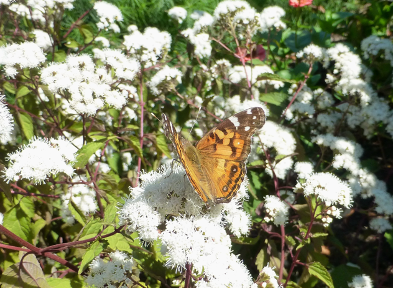
This late-blooming perennial is an ideal addition to the landscape for a bloom that can last from September into late October. Bees that are active late in the season will benefit from these late flowers. Related to the Joe-pye weeds, this plant likes moist soil and full sun to part shade for optimum flowering. It does tolerate drier conditions. Common Name: Chocolate Snakeroot, Joe-Pye Weed
Eupatorium rugosum ‘Chocolate’
American Oil Beetles
American oil beetles are a member of the beetle family Melòidae, the blister beetles. These blister beetles cannot fly, and they are often seen crawling over lawns and on roads and sidewalks in October as they look for a suitable place to spend the winter. They are sometimes pests of vegetables and some perennials. Above, left, an oil beetle on parsley. Blister beetles may release a chemical when alarmed that can cause skin to blister. Oil beetle larvae are parasitoids of certain solitary ground-nesting bees. Adults eat plant material.
Knowledge to Grow On
Read our Ladybug blogs written weekly! Here’s November’s Highlights:
Fall Cleanup Provides an Opportunity for Dazzling Dried Bouquets!
Upcoming Events & Things to Do
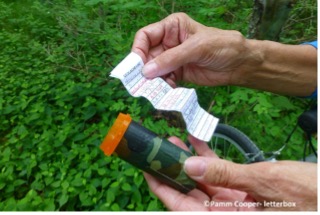
- Take a Fall Foliage Drive – These self-guided, drivable tours of the fall foliage are a fantastic way to take in the local autumn colors. They even recommend stops along the way!
- Wine & Design: Craft your Thanksgiving Centerpiece – Create your own seasonal centerpiece using a selection of fresh-cut flowers and accent pieces curated by Amy Sapirstein of Eye Candy Florals. Registration required.
- Mattabasett Trail – Located near Middlefield, CT. There are spectacular views even in November as oaks should be in full fall foliage color.
- Consider buying local produce, baked goods, turkeys and other goodies for your Thanksgiving dinner. We’ve found a few to get you started:
| Ekonk Hill Turkey Farm in Sterling
Maple Bank Farm in Roxbury |
Gozzi’s Turkey Farm Guilford
Clark’s Farms at Bushy Hill Orchard in Granby Silverman’s Farm in Easton |
- Manchester Road Race – Take part as a runner in the 43rd Manchester Road Race on Thanksgiving Day or enjoy as a spectator along the route!
- Holiday Light Festival & Market – Enjoy interactive light gardens, illuminated structures, seasonal food and drinks, family-friendly activities, a festive holiday market and daily live entertainment.
- 1881 Series featuring UConn Brewing Innovation & Student Brewed Can Release – Join us at Kinsmen Brewing Co. to help us launch UConn Brewing Innovation, including a collaborative brewing effort with UConn students and great breweries in Connecticut, with our goal of growing our impact on the Connecticut brewing scene
Educational Opportunities & Workshops
- The Gardener’s Guide to Prairie Plants – This national webinar will be held November 16th at 6:00PM. Authors Neil Diboll & Hilary Cox will discuss their book, The Gardener’s Guide to Prairie Plants
- James L. Goodwin State Forest letterboxing program – registration is required for this program which will take place on November 20, 2023 at the James L. Goodwin State Forest in Hampton.
- Winter Birds – Gain an understanding of birds that spend the winter in Connecticut. Learn how to identify by recognizing characteristics and behaviors. We will walk the habitats in search of species and end at the center’s feeding stations. Wrap up by making a simple feeder to take home with you by repurposing a plastic bottle. Registration is required.

Information and Registration at https://www.cfba.org |
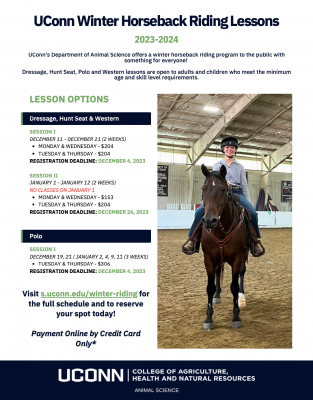
Information and Registration at s.uconn.edu/winter-riding |
November Gardening Tips
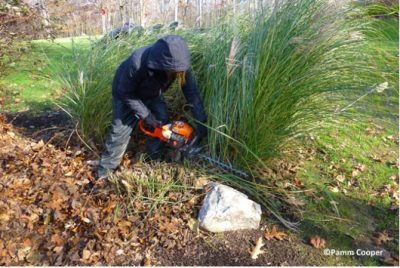
- It’s your last chance to plant bulbs in the first week of November.
- Be sure not to store apples or pears with vegetables. The fruits give off ethylene gas which speeds up the breakdown of vegetables and will cause them to develop a strange taste.
- Cut back most perennials to 3-4 inches, but ornamental grasses can be left to provide winter interest.
- Asian lady beetles, Western Conifer Seed Bugs and Brown marmorated stink bugs may enter the home to overwinter. Use weather stripping or caulking to keep them out.
- Continue to thoroughly water trees, shrubs, planting beds, lawn areas and recently planted evergreens until a hard frost. Plants should go into the winter well-water.
- Be persistent in collecting leaves that fall late as it will make cleanup in the spring much easier.
- Keep mowing your lawn as long as the grass is growing. Meadow voles and field mice will damage turf and nearby trees and shrubs if they have long grass for food and cover.
- Clay and ceramic pots can crack over the winter if they fill with rain or melted snow that subsequently freezes and expands. Empty pots and place them upside down under a tarp or store them in a shed or the garage
- Drain Garden hoses and store in a shed, garage, or basement for the winter. Turn off all outside faucets.
- Pull stakes and plant supports. Clean them with a 10% bleach solution before storing them for the winter.
Bonus Tip: Ornamental grasses can be cut back for the winter or left as they are if winter interest is desired. The tall grasses are a suitable place for birds to find shelter during the winter.
Notice something going on in your garden? The UCONN Plant Diagnostic Laboratory diagnoses plant problems including diseases, insect pests and abiotic causes. Submitting a sample is easy! For details, visit the UConn Plant Diagnostic Laboratory
Have Your Soil Tested for Macro- & Micronutrients: Send your soil sample in for testing now to avoid the spring rush. For details on submitting a sample, go to the UConn Soil Nutrient Analysis Laboratory
Photo Op: Fascinating Sights in the Garden
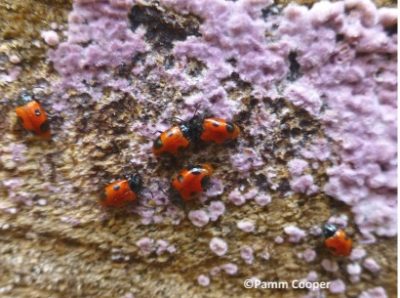
Diaperis maculata Olivier fungus beetles on Phlebiopsis crassa fungus on a decaying log
See something cool in your garden? Send your pictures to us at ladybug@uconn.edu with subject line “Newsletter Photo” and a brief caption to be considered for next month’s highlight!
Before We Go…
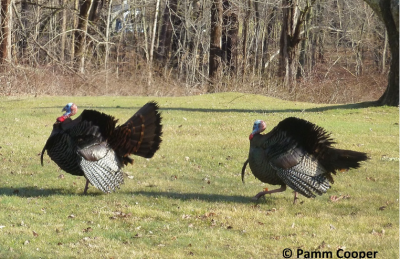 Did you know…The USDA estimated that more than 46 million Turkeys were eaten across the United States on Thanksgiving last year!
Did you know…The USDA estimated that more than 46 million Turkeys were eaten across the United States on Thanksgiving last year!
UConn Extension offers food safety guidance for home cooks all year; but the holidays are a suitable time to review your home practices to ensure safe preparation, cooking and storage of leftovers through the holiday season.
This Month’s Newsletter Contributors:
Pamm Cooper, Dr. Nick Goltz, Dawn Pettinelli, Marie Woodward, Heather Zidack
